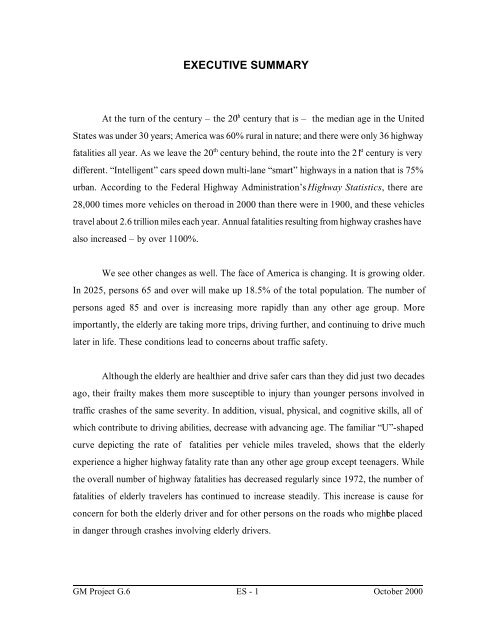Projecting Fatalities in Crashes Involving Older Drivers, 2000-2025
Projecting Fatalities in Crashes Involving Older Drivers, 2000-2025
Projecting Fatalities in Crashes Involving Older Drivers, 2000-2025
Create successful ePaper yourself
Turn your PDF publications into a flip-book with our unique Google optimized e-Paper software.
EXECUTIVE SUMMARY<br />
At the turn of the century – the 20 th century that is – the median age <strong>in</strong> the United<br />
States was under 30 years; America was 60% rural <strong>in</strong> nature; and there were only 36 highway<br />
fatalities all year. As we leave the 20 th century beh<strong>in</strong>d, the route <strong>in</strong>to the 21 st century is very<br />
different. “Intelligent” cars speed down multi-lane “smart” highways <strong>in</strong> a nation that is 75%<br />
urban. Accord<strong>in</strong>g to the Federal Highway Adm<strong>in</strong>istration’s Highway Statistics, there are<br />
28,000 times more vehicles on the road <strong>in</strong> <strong>2000</strong> than there were <strong>in</strong> 1900, and these vehicles<br />
travel about 2.6 trillion miles each year. Annual fatalities result<strong>in</strong>g from highway crashes have<br />
also <strong>in</strong>creased – by over 1100%.<br />
We see other changes as well. The face of America is chang<strong>in</strong>g. It is grow<strong>in</strong>g older.<br />
In <strong>2025</strong>, persons 65 and over will make up 18.5% of the total population. The number of<br />
persons aged 85 and over is <strong>in</strong>creas<strong>in</strong>g more rapidly than any other age group. More<br />
importantly, the elderly are tak<strong>in</strong>g more trips, driv<strong>in</strong>g further, and cont<strong>in</strong>u<strong>in</strong>g to drive much<br />
later <strong>in</strong> life. These conditions lead to concerns about traffic safety.<br />
Although the elderly are healthier and drive safer cars than they did just two decades<br />
ago, their frailty makes them more susceptible to <strong>in</strong>jury than younger persons <strong>in</strong>volved <strong>in</strong><br />
traffic crashes of the same severity. In addition, visual, physical, and cognitive skills, all of<br />
which contribute to driv<strong>in</strong>g abilities, decrease with advanc<strong>in</strong>g age. The familiar “U”-shaped<br />
curve depict<strong>in</strong>g the rate of fatalities per vehicle miles traveled, shows that the elderly<br />
experience a higher highway fatality rate than any other age group except teenagers. While<br />
the overall number of highway fatalities has decreased regularly s<strong>in</strong>ce 1972, the number of<br />
fatalities of elderly travelers has cont<strong>in</strong>ued to <strong>in</strong>crease steadily. This <strong>in</strong>crease is cause for<br />
concern for both the elderly driver and for other persons on the roads who mightbe<br />
placed<br />
<strong>in</strong> danger through crashes <strong>in</strong>volv<strong>in</strong>g elderly drivers.<br />
GM Project G.6 ES - 1 October <strong>2000</strong>
















